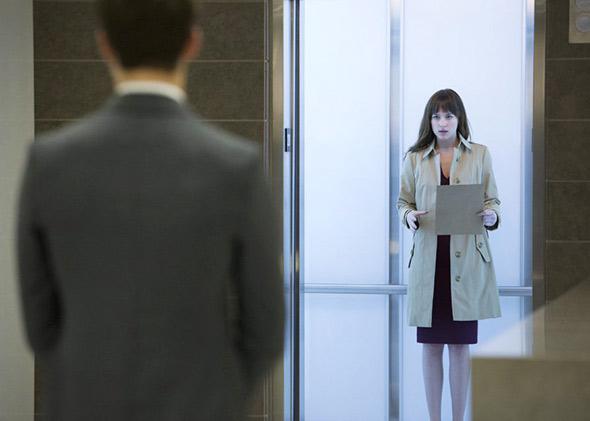Fifty Shades of Grey, which sold 100 million copies by stealing the plot of every ’70s-era Harlequin romance and adding BDSM, started out as Twilight fan fiction and has now morphed into a box office winner starring the daughter of ’80s-era Hollywood stars. What does it all mean? Several writers in the past week, including Slate’s own, have tried to explain what Christian Grey and Anastasia Steele say about society, sex, and the state of the human soul, circa 2015. Here are some of the highlights.
Lizzie Crocker of the Daily Beast says Fifty Shades shows that American audiences want to believe they are transgressive, but they’re actually pretty boring. Anthony Lane of the New Yorker concurs, coming up with colorful ways to accuse the fans of being basic without using that word:
And there you have the problem with this film. It is gray with good taste—shade upon shade of muted naughtiness, daubed within the limits of the R rating. Think of it as the “Downton Abbey” of bondage, designed neither to menace nor to offend but purely to cosset the fatigued imagination. You get dirtier talk in most action movies, and more genitalia in a TED talk on Renaissance sculpture…. Clauses and subsections are haggled over in such detail that one feels bound to ask: How much of a sex film can this be, given that the people most likely to be turned on by it are lawyers?
But some worry that Fifty Shades has darker lessons. Leslie Bennetts, writing for Entertainment Weekly, argues that Fifty Shades shows women’s sexual desire is still constrained and distorted by a sexist society:
In fact, because virtually all cultures stigmatize unrestrained female sexuality, coercion has always featured prominently in sexual narratives. For some women, being forced to have sex alleviates guilt, a major reason for the existence of rape fantasies. “One appeal of submission for women is the desire to feel highly sexualized without taking responsibility for it: ‘It’s not my fault I’m this turned on, it was imposed on me,’ ” explains Dr. John Jacobs, a psychiatrist and author of All You Need Is Love and Other Lies About Marriage. For women and men, he says, “there’s a desire, perhaps built into the human psyche, for both being in control and at the same time not being responsible.”
Emma Green of the Atlantic agrees, worrying that Fifty Shades romanticizes domestic abuse in its portrayal of a woman giving “consent” under coerced circumstances:
This is a troubling fantasy in American culture, where one in five women will be raped within their lifetime, according to the CDC; where nearly 40 percent of those rapes will happen to women aged 18 to 24; and where troubling evidence of casual attitudes toward rape—such as in 2010 when a number of Ivy League-educated men thought it was okay to chant “no means yes, yes means anal” on their campus—is not uncommon. As images of Ana being beaten by Christian become the new normal for what’s considered erotic, they raise questions about what it means to “consent” to sex. Clearly, consent is necessary; but is it sufficient?
Karen Boyle of the Conversation is more direct:
This is consistent with a wider cultural script in which obsessive male behaviour and men’s sense of entitlement to women is still too often legitimated, with concrete, material effects on women’s safety and lives. Ana agrees to marry Christian aged 21, and just weeks into their relationship, because he needs reassurance that she is “his”, she modifies her behaviour to contain his rage, in recognition of the maternal neglect and paedophilic abuse (by an older woman) which has brought him here. Male violence is women’s responsibility.
While many feminists believe that Fifty Shades is just regurgitating the same sexist tropes in a fancy new BDSM guise, some conservatives appear worried that Fifty Shades is yet another example of how the collapse of civilization is upon us. Mark Davis of the Dallas Morning News provides a classic example:
It is evidence of a damaged society, a nation that thinks it is just swell to celebrate the story of a predatory billionaire punk who victimizes a tragically vulnerable woman for his own sick entertainment.
And, in what may be the clear winner in the most entertaining Fifty Shades think piece contest, here is Joseph Heschmeyer of the Catholic magazine First Things who argues that the book shows women are longing for a prefeminist era and are just afraid to admit it:
This dissatisfaction extends to the bedroom. Spouses in gender-fluid marriages have less sex, and less satisfying sex. Researchers have found that the “more traditional the division of labor, meaning the greater the husband’s share of masculine chores compared with feminine ones, the greater his wife’s reported sexual satisfaction.” Here, it seems, 50 Shades of Grey comes into play, tantalizing readers with a world in which men aren’t afraid to lead, and women feel safe submitting.
Sadly for Heschmeyer, advance ticket sales were higher in conservative areas where women already feel, um, safer to stick to traditional gender roles, dramatically undermining the theory that its popularity is due to liberated women secretly longing to be put in their place.
